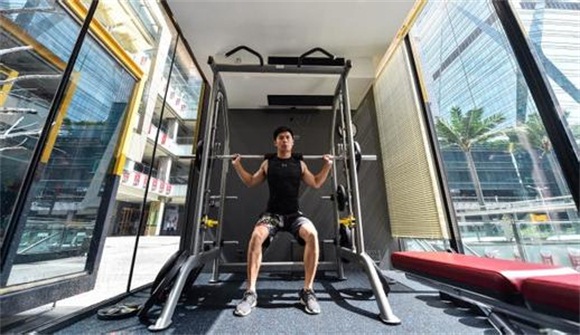The sharing economy has become an important part of China’s service sector in recent years, as bikes, umbrellas, cars, portable chargers and sleep capsules have been made sharable across the country.
According to a report posted by the State Information Center, the total value of China’s sharing economy will see an annual growth of 40% in the coming years, which is expected to contribute around 10% to the country’s GDP by 2020.
Recently, a sharing mini-gym rental business has popped up in some Chinese cities like Beijing and Chengdu. Misspao, along with its rivals All Love Fitness, Xiaoxiong Kuaipao, Douba, and LEOAO, have become active players in the sharing economy-based fitness market.
Beijing-based startup Misspao is one of the enterprises following this business model to take a piece of the fitness market. Unlike crowded and smelly traditional gyms, Misspao mini fitness pods allow only one or two customers to use it at a time. The 4-square-meter room is equipped with a treadmill, fitness accessories, television, air conditioners as well as an air purifier.
All you need is a smart phone to download an app, scan an access code and start your fitness experience. You are charged 0.2 yuan per minute while using the facility. This self-service business model has earned Misspao tens of millions of Yuan in funding, allowing it to be valued at over RMB 100m (US $15m).
Misspao finds that 10% of white-collar workers in Beijing have purchased a fitness service even though not all of them can go to the gym regularly. The company sees uptown as their major market. “Up to now, sharing-economy services are still targeting the commercial areas, schools, and campuses, which allows uptown to remain an untapped market,” said Bi Zhen, Founder of Misspao.
“A traditional course for a fitness instructor cost me 400 or 500 yuan, and I can’t even afford the 7000 yuan bill every month,” a fitness enthusiast from Qingdao said. “It would be nice if we can share a fitness instructor in a way similar to the shared gym model.”
Mark Luo, a veteran with 18-year experience in fitness, believes this difficulty cannot be solved merely by increasing the number of personal trainers or cutting the charge.
Determined to disrupt the market, Luo established the fitness brand YESOUL Smart Cycling, taking the courses of fitness instructor to users’ living rooms using Internet live streaming technology. The 2017 Red Dot: Best of Best winner helps users save money and time in their daily exercise regimens.
But how does a sharing gym make a profit? Let’s return to Misspao’s model. As the company says, their annual expenditure for a fitness pod is about 15,000 yuan, consisting of a 10,000 yuan equipment cost and 5,000 yuan cost in energy consumption, including depreciation and operation. The company will net a profit if it can make sure each pod will be used for 5 or 6 hours every day, which means 70 yuan in daily turnover.
In short, the secret of a sharing economy-based gym is attracting more customers. The good news is, China has been encouraging its citizens to participate more in sports activities.
According to a national fitness plan released in 2016, China has set up ambitious targets for increased sports participation and national fitness levels. The country aims to make the health and fitness expenditure reach RMB 1.5 trillion (about 228 billion US dollars) by 2020, while the number of citizens engaging in physical exercise as a weekly routine is expected to reach 700 million during the same period.
As Liu Guoyong, an officer of China’s sports governing body, once said, “different from the program for the last five years, we have changed our perspective on sports. At present, we believe sports should be combined with education, culture, tourism and the medical industry.”
According to open data, China’s fitness market was valued at $15 billion to 20 billion while the number of gyms per million people was 4.3 by the end of 2015. At that time, the country had 4,425 fitness clubs, a 20% year-on-year increase, and about 6.64 million fitness club members, an increase of 21.3%.
As we can learn from the data above, the fitness industry in China has much more room to be occupied, which will undoubtedly attract more business opportunities for sharing fitness start-ups in the country. That’s why Misspao is looking to roll out 1,000 more shared pods in Beijing by the end of 2017.
Proofread by William Logsdon
